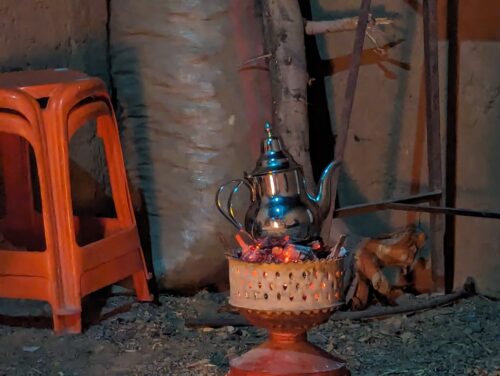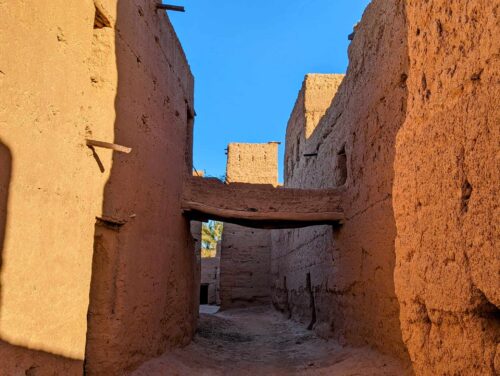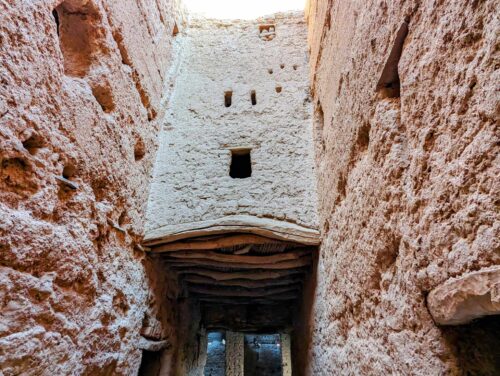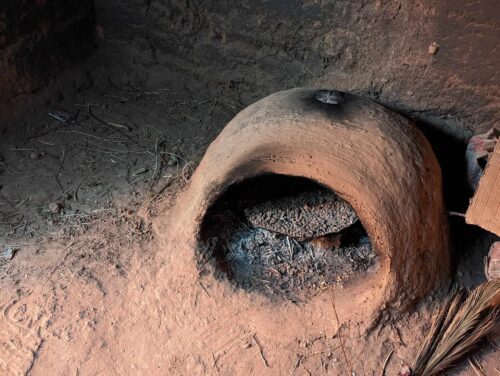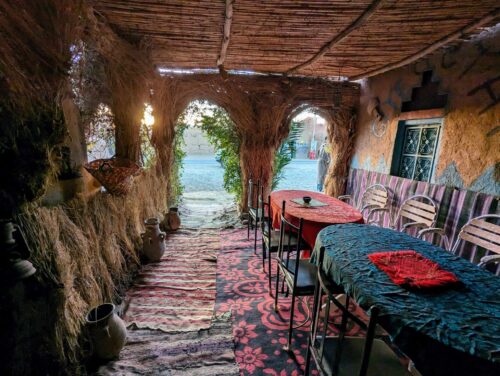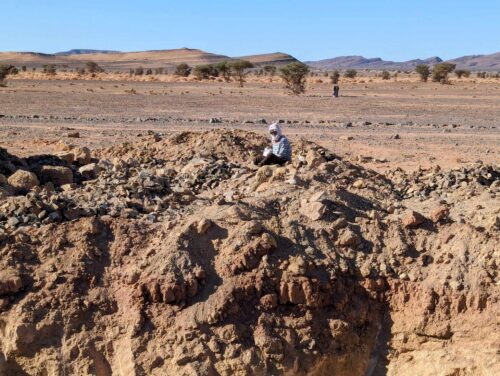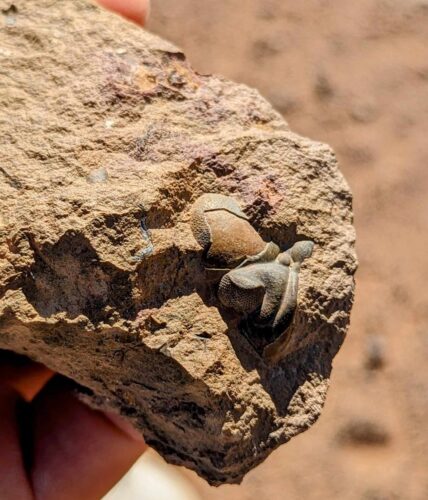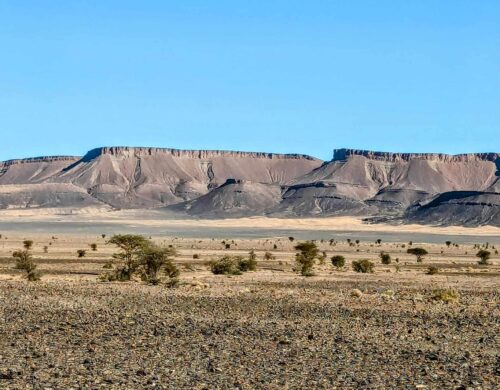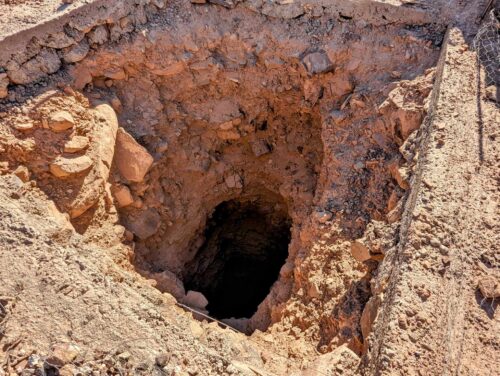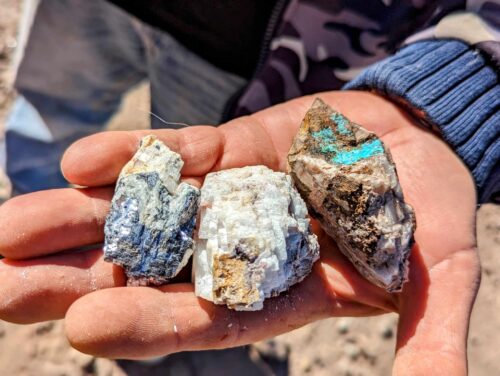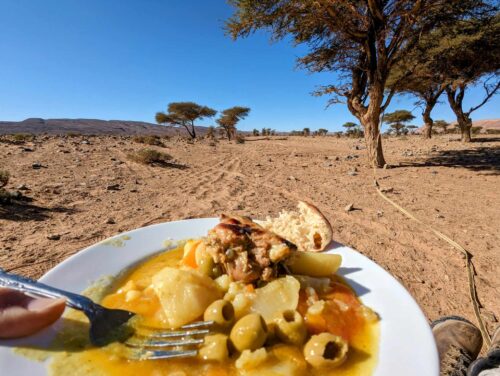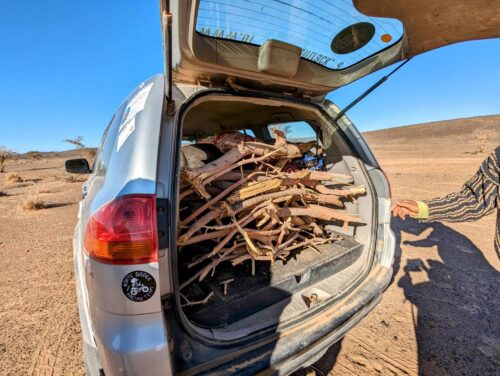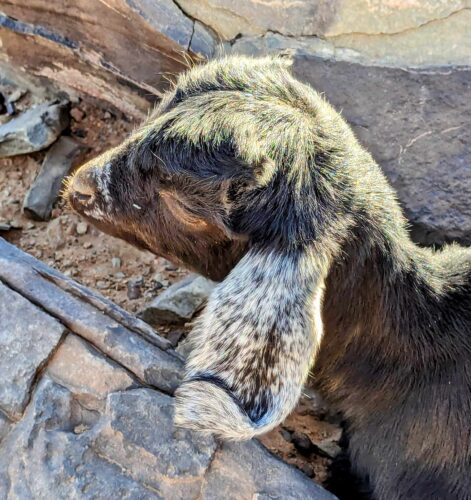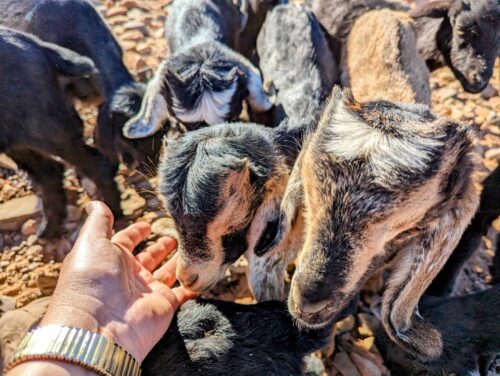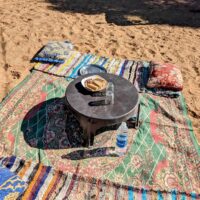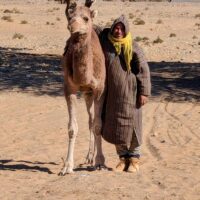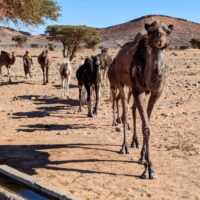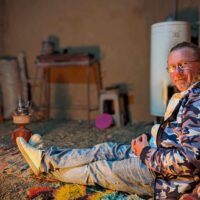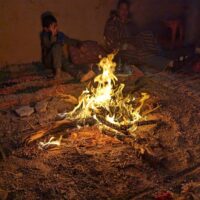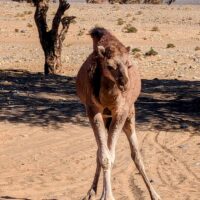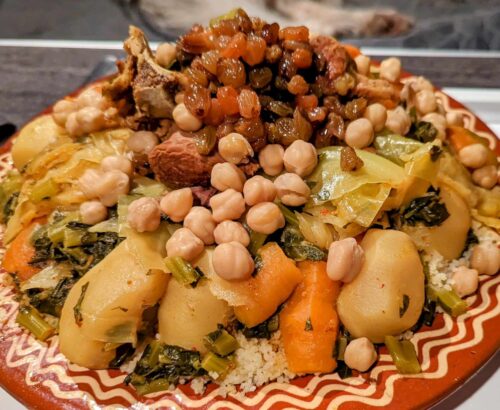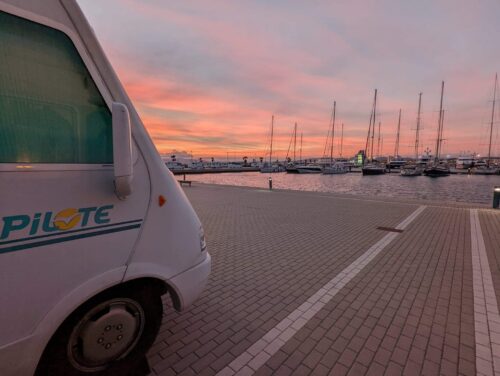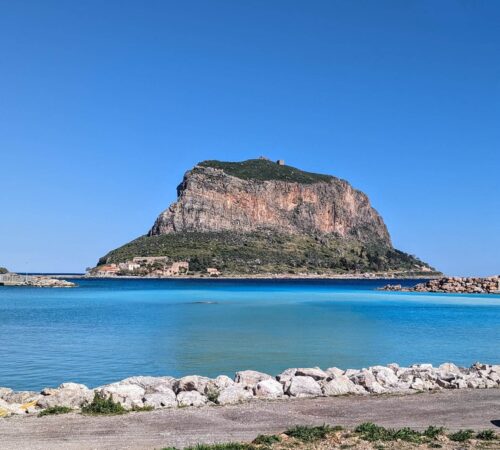The Sahara may be the largest hot desert in the world, but it isn’t wholly composed of beautiful golden dunes. There are several distinct ecological regions, and even the central arid part of the desert isn’t totally covered in sand dunes. Vast areas of stone plateaus, gravel plains, dry valleys, and salt flats are common.
The black desert is so called because of the rocky black schist covering the ground. It is a barren, unforgiving region. A few acacia trees dot the landscape, but little else grows there. The rocky ground and lack of water makes agriculture all but impossible. It hasn’t rained for 5 years and the black rocks mean summer temperatures are off the scale. Yet somehow people still manage to eke out a living.
Fezzou
Merzouga, Sidi Ali and M’Hamid are connected via the Ouzina piste, a popular route for 4×4 enthusiasts. Sadly our motorhome wouldn’t have made the drive.
We had no choice but to retrace our steps and head for Sidi Ali via the N12. From the N12 it’s still quite a long way down a minor road to get there. We got as far as Fezzou, before deciding to stop for the night.
The tiny hamlet of Fezzou
Fezzou is a tiny hamlet of around 200 families, located within the region known as the black desert. It was in Fezzou that we met Brahim and his family. Brahim studied law and is multilingual. Born and raised in Fezzou he has returned to the family home to give something back to the community.
The family run a small shop in the village, a restaurant, museum and a campsite. The father, three brothers, their wives and children all live together in the family home, 13 of them altogether.
We stopped with the intention of stopping for just one night and clearing out early the following morning. However Brahim had other ideas.
A village in the Black Desert
We were welcomed with open arms. The whole family so friendly and accommodating. They insisted we accompany them in their 4×4 to see their local Kasbah.
Market Stall
Along the way stopping at a small market stall where Brahim explained that the stalls come once a week, mainly so the ladies can buy clothes for themselves and their children, together with an assortment of household items.
Apparently, the men will go off to the markets in the bigger towns once a week to buy provisions, where they can also get anything else they need, while the women folk stay at home. Hence the need for the small mobile stalls, which rotate around the local villages.
The Kasbah
From there it was a short drive to the Kasbah. Unlike some other kasbahs, which were built by rich merchants for their families and were often a show of wealth, this was built during more troubled times for the protection of the people. The whole community lived within its walls, sharing everything.
The mosque and well were just outside the Kasbah so it wasn’t far to go to pray or get water – it’s not a great Idea to have a lot of water near the mud walls…..
Village Life
Life in the Kasbah
It seems a very alien way of living to us. It’s hard to imagine a whole community living in a single dwelling. The lack of privacy and personal space must have been difficult.
The Kasbah isn’t occupied today but is still in a good state of repair. Brahim tells us that it has only been recently that the villagers have had an electricity supply.
The single entrance and the passageways under the living accommodation are still intact. A fascinating building brought to life by Brahim with his wealth of knowledge of the history of the local area.
The Daily Bread
We stopped also at a community bread oven, still being used every day. It is lit every morning and around 20 families will use it to bake their bread.
The village Shop and Restaurant
On the way back we stopped briefly at the shop and restaurant in the village to have a look around. The shop is a treasure trove of almost everything the villagers might need. The restaurant is basic but authentic rather than dressed up for the tourists.
In the evening we were invited to join the family for dinner around the campfire. A truly memorable experience.
The Black Desert
A Guided Tour through the Black Desert
I’m not entirely sure how we ended up agreeing to a tour with Brahim, but somehow we did and it was up there with the best things we have done so far this trip.
We were due to set off around 9.30, although a slight delay meant we were away shortly after 10. After around 20 minutes of off-road driving, and a short stop to collect firewood for our picnic (the thorns on the acacia are wicked), we arrived at the fossil fields, our first stop.
Black Desert Fossil Hunters
Fossils were first found in the area on the surface, but that supply was quickly exhausted. The seam of rocks containing the fossils runs gradually downwards. Initially, just below the surface they were easy to extract, but they slowly got deeper and deeper the further you go from the original site. The seam runs for many kilometres, evidenced by the piles of earth and broken rocks.
Today the seam they are working on is around 4 meters below the surface. Trenches are dug mechanically, and the rocks sorted by hand, carefully being broken open to see what lays inside. We would all like to think that every rock contains a fossil, but of course in reality that’s nowhere near the case.
A handful of people, hammer in hand, chipping away at the rocks, ever hopeful of finding that perfect specimen. Working from dawn to dusk, sifting through the rocks one by one. Hot, dusty work, in the middle of nowhere and in extreme temperatures.
It would have been nice to have had a go ourselves, but without tools, it wouldn’t be possible to break the rocks. Also, we wouldn’t want to offend the people for whom it is their living.
However, according to Brahim, it would be possible to talk to one of the prospectors so they can explain what they do and show you how it’s done. Something hopefully he will include in future tours.
Mining Moroccan Style
From there we went a short distance to see a working mine. Another eye opener. Vertical shafts 100 m deep with someone at the bottom filling the hoppers by hand, which are then winched to the surface mechanically. There were perhaps half a dozen shafts being mined, each with its own winch and generator.
The Black Desert has reserves of copper, manganese, gold and silver, cobalt, tin, titanium, and tungsten in the area. The mining industry is very important to the Moroccan economy. For the workers, however, it is hot, hard, dirty work in cramped, dangerous conditions. Health & Safety? Pfft!
Lunch Break
Next up, by way of contrast, we head to some sand dunes nearby. Formed by wind blown sand collecting in the lee of the hills, these were not especially large, but completely pristine, without a single footprint or tyre track to be seen. Fantastic views across the black desert with no sign of human habitation in any direction.
A short drive to a nomad well where we stopped for lunch. A family of camels were taking on water, mum, dad and offspring of various ages.
A fire was quickly built and soon blazing away and in no time we had the ubiquitous Berber Whiskey with nuts, wafers and olives while we waited for the food to cook. A simple vegetable stew with hunks of turkey, and Berber bread of course. Tasty and filling,
Life Of A Black Desert Nomad
Tea with a nomad family
After a leisurely lunch we paid a visit to a nearby Berber nomad family. Very hospitable and welcoming, and of course there was more Berber Whiskey.
The family live in dwellings constructed simply of piled up stones, with a few logs over the top covered in mud for shelter. The women and children stay in one place now, while the menfolk are away with their herd of goats.
The camp is near a well which supplies a village over 20 km away, the water pumped across the black desert schist. The family is paid a small amount of money each month to keep an eye on the well and make sure it keeps working properly.
Just Kidding
A couple of enclosures, again built with dry stone walls, house the animals overnight. The smaller one had the kids in. Initially we could only see a couple, but after asking permission Carol made her way over and was soon surrounded by a dozen or more kids.
The family donkey, kept to carry firewood back to the dwellings, was roaming free, inquisitive and friendly, although keeping its distance because of Zeus.
No crops are grown, the land is too hard to tend and the conditions too harsh. They have to rely solely on the goats for their livelihood.
A brief insight into the hard day-to-day life of these people. Despite the hardships their faces are full of joy and the children playing and laughing. Because of the remote location the children don’t attend school. Instead they will learn how to survive in such a harsh, remote, desolate place.
Why not have a look at my other sites....
Helping you save money on your everyday bills
Balancing finances isn’t easy. Often there doesn’t seem enough to go around, or there’s little left for the important things in life.
We would all like a bit extra to spend on the things we want to do, and it’s possible with a bit of thrifty living. This site is packed with hints and tips to save money, allowing you to do more of what you want.
Answering p-mails the world over
An ex street dog from Cyprus, an ex-pub dog from Devon, ex ex-overnight security dog and now enjoying my time travelling with my mum and dad.
My hoomans and I explore the world in their big white box on wheels, although that work fing gets in the way sometimes. So far we have travelled mostly around Europe, but have also been to Morocco in Africa.
Hope You Enjoy!
Please leave us a comment!


